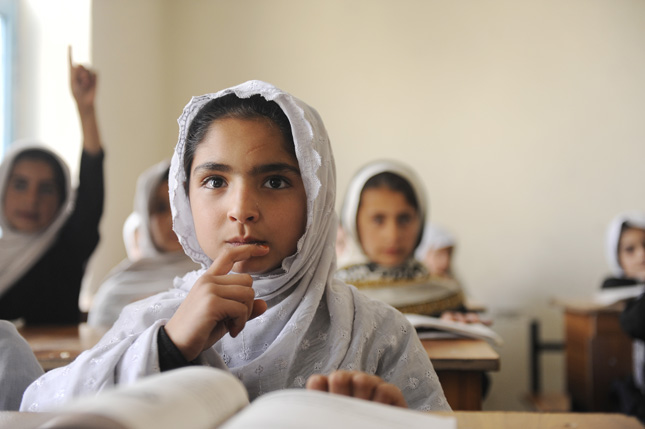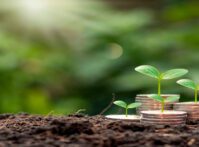-
To Fight Climate Change, Educate and Empower Girls

Girls and women bear the brunt of climate change impacts. Natural disasters kill more women than men: an estimated 90 percent of those killed in some weather-related disasters were female. The effects of climate change on natural resources can also further exacerbate existing gender inequalities. Girls may be kept out of school to fetch water, as droughts drive them to walk farther and farther to find it. Seeking to stretch scarce household resources, families may marry off their daughters before the legal age and they may become more vulnerable to human trafficking after natural disasters.
Investing in education for girls can make the difference between life and deathInvesting in girls’ education can not only reduce girls’ and women’s vulnerability to weather-related disasters, it can also address the underlying gender inequalities that increase their marginalization and exploitation in the face of climate change. In our new report, Three platforms for girls’ education in climate strategies, we argue that investing in education for girls can make the difference between life and death: from developing life-saving skills like literacy and risk assessment, to more complex competencies like the ability to negotiate against early marriage and advocate for their personal rights. It’s time to begin expanding our climate strategies beyond technical solutions, like developing renewable energies, to include sociological solutions, like investing in girls’ education.
A Neglected Climate Correlation
On a macro level, girls’ education may play a much larger role in a country’s resilience to climate change than currently understood. Our back-of-the-envelope calculations suggest that for every additional year of schooling a girl receives, on average, her country’s resilience to climate disasters (as measured by the ND-GAIN Index) improves by a significant 3.2 points. This correlation between a country’s female education levels and its resilience to climate disasters is stronger in countries where girls have achieved at least 10 years of schooling on average. More analysis of this correlation is needed to understand the other factors involved and to identify any causal relationships, but the work of William Butz and his colleagues at the Wittgenstein Center finds similar relationships between educational attainment and adaptive capacity.
ND-GAIN Index Country Rankings and Girls’ Education Levels
Average years of
schooling for girls
(UNDP 2016)ND-GAIN Index score
(higher scores = lower
climate vulnerability)TOP FIVE Denmark 12.6 81.3 New Zealand 12.6 80.6 Norway 12.8 80.6 Singapore 11.1 78.8 United Kingdom 13.2 78.5 BOTTOM FIVE Sudan 3 30.6 Burundi 2.6 30.1 Eritrea no data 25.5 Chad 1.2 25.3 Central African Republic 2.8 24.8
Investing in girls’ education for climate action promises to increase humanity’s capacity to develop diverse technical and sociological solutions for adapting to and mitigating climate change. But thus far, early life solutions for girls have largely been neglected; when female vulnerability is acknowledged at all, global efforts have focused on adult females, not girls. While the global community has recognized that achieving the Sustainable Development Goals requires multi-sectoral action, climate strategies have failed to integrate other sectors on the whole.Three Platforms for Integrating Girls’ Education and Climate Change
Our report lays out three action platforms through which actors from the gender, education, and climate sectors can collaborate and support girls as agents of change:
- Promote girls’ reproductive rights to ensure equitable climate action
A clear link exists between higher levels of female education and lower rates of fertilityThe intersection that has captivated the education and demographic communities alike is the role of fertility: A clear link exists between higher levels of female education and lower rates of fertility. But, efforts that aim merely to reduce fertility rates and stabilize population growth without respecting reproductive rights are complicated by globally shared ethical concerns. It is crucial that actors approach increasing access to reproductive health from a gender justice and rights-based perspective, delivered through quality girls’ education programming.
Key to this shift is connecting organizations like CARE and Plan International—that focus on the rights and empowerment of women and girls—with other actors like Pathfinder, The Nature Conservancy, and the Sierra Club that take an integrated approach to combining reproductive health services with environmental efforts including climate change. Climate financing mechanisms like the Adaptation Fund should include investments in girls’ and women’s reproductive rights and education as part of their policy mechanisms. And, overseas development assistance accountability mechanisms like the OECD DAC should include girls’ education and reproductive health as a climate aid “gender marker” alongside their existing gender markers.
- Invest in girls’ education to foster climate participation and leadership
Women comprise only a small percentage of the world’s most influential environmental decision-making bodies and hold only 12 percent of the leadership positions in the world’s environment ministries. Meanwhile, other studies show that female leaders are incredibly effective in conservation and protection efforts, and are more likely to pursue more sustainable futures for their communities.
While efforts to increase women’s participation and leadership ultimately seek to empower women, their focus on adult women misses a critical opportunity to take a systemic approach to early learning that could build a pipeline of future leaders. Our research in girls’ life skills education makes clear that developing skills like leadership as early as possible is key to achieving girls and women’s empowerment. While women-centered initiatives like WEDO’s Women Delegates Fund, the International Gender Champions Network, or the Women Political Leaders Global Forum are significant in the short term, the cycle of low female participation and leadership in climate action will continue if the global community doesn’t engage girls’ leadership development.
- Develop girls’ life skills for a green economy
Few women are positioned to lead green sector companiesThe transition to a green economy has become a catch-all climate mitigation solution attracting multilaterals, corporations, governments, and civil society due to its promise of reconciling the paradoxes of economic development and environmental degradation. However, current workforce development efforts to retrofit women’s skills for green sector jobs come too late in a woman’s life, especially in regions with low levels of female education. And few women are positioned to lead green sector companies; for example, only five percent of executive board members at the top 200 power and utility companies are women.
Actors such as the European Centre for the Development of Vocational Training (Cedefop), the International Labour Organization, and the OECD—those that focus on building and monitoring green skills for inclusive growth—must extend green-sector training and green skills development to girls and female youth through tailored girls’ education programming. Moreover, girls’ education actors focused on life skills development and on getting girls into science, technology, engineering, and mathematics (STEM) fields, like the United Nations Girls’ Education Initiative’s UN Ivy STEM Connect Program, must begin to connect their agenda to green-sector career pathways.
These platforms offer opportunities to open new discussions across sectors among actors who are working on the same issue from varying perspectives. Despite having common ambitions, these actors are often disconnected from each other by their different approaches: gender advocates focused on increasing women’s participation in climate action; educators focused on developing skills in climate and STEM; and climate actors focused on technical solutions like clean energy solutions. In addition to bridging the gaps between these groups, we must also engage new global champions of climate change and holding them accountable for leading multipronged and integrated global solutions.
While there are remaining gaps and persisting questions, achieving gender equality and women’s empowerment cannot wait, not only because it is the right thing to do, but because it is key to mitigating the existential threats posed by climate change. Recent disasters from Bangladesh to Sierra Leone to the United States and the Caribbean have made it clear the time to act is now. Girls’ education is a foundational step to addressing the challenge of climate change through dynamic solutions that not only include girls and women, but tap into their human potential to tackle it.
Christina Kwauk is a postdoctoral fellow at the Center for Universal Education in the Global Economy and Development program at the Brookings Institution.
Amanda Braga is a research analyst at the Center for Universal Education in the Global Economy and Development program at the Brookings Institution.
Sources: Adaptation Fund, Al Jazeera, Brookings, Ernst & Young, European Centre for the Development of Vocational Training, International Gender Champions, International Labor Organization, International Union for Conservation of Nature, Notre Dame Global Adaptation Initiative , Organization & Environment, Organisation for Economic Co-operation and Development, Review of Radical Political Economics, UNICEF, United Nationas Environment Programme, United Nations Girls Education Initiative, Washington Post, The Women Political Leaders Global Forum, Women’s Environment and Development Organization
Photo Credit: A girl at Ayno Meena Number Two school in the city of Kandahar, Afghanistan, which was built in late 2008 with support from the World Bank, March 2014, courtesy of Global Partnership for Education
 A Publication of the Stimson Center.
A Publication of the Stimson Center.






